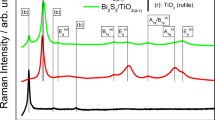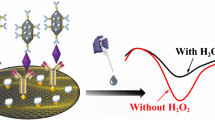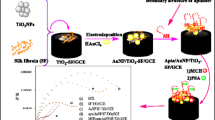Abstract
We report on the synthesis of flower-like 3D titanium dioxide (fl-TiO2) using a hydrothermal method. This material possesses a large specific surface and displays an electrochemiluminescence (ECL) intensity that is much stronger than the one of TiO2 nanoparticles having smooth surfaces. It was used to label the secondary antibody in a sandwich immunoassay. A thin layer of metallic gold (Au) and palladium (Pd) was deposited on an indium tin oxide (ITO) electrode by code-position at a potential of 0.2 V in the respective chloride solutions. The Au/Pd-modified ITO electrode showed good conductivity. An ECL based immunoassay for the prostate specific antigen (PSA) was then worked out by immobilizing the first antibody on the Au/Pd layer on the ITO electrode, then exposing the electrode to a sample containing PSA, then forming the sandwich with the fl-TiO2 labeled secondary antibody, and finally measuring the intensity of ECL at a potential of −1.5 V. This ECL sensor has a response range that extends from 0.001 to 600 ng∙mL−1, a lower detection limit of 0.32 pg∙mL−1, good specificity, acceptable stability and good reproducibility. It gave satisfactory results when used for the determination of PSA in (spiked) diluted solutions of human serum.

Designed an ECL immunosensor for the detection of PSA based on Au/Pd modified ITO glass electrode and using fl-TiO2 as signalling labels. Ab1 and Ab2 were covalently bound to Au/Pd and fl-TiO2, respectively, to fabricate a sandwich-type immunosensor.








Similar content being viewed by others
References
Lee JK, Lee SH, Kim M, Kim H, Kim DH, Lee WY (2003) Organosilicate thin film containing Ru(bpy)3 2+ for an electrogenerated chemiluminescence (ECL) sensor. Chem Commun 13:1602–1603
Zhang XR, Baeyens WRG, Ouyang J (1999) Recent developments in chemiluminescence sensors. Anal Chem 6:384–391
Liu X, Jiang H, Lei J, Ju H (2007) Anodic electrochemiluminescence of CdTe quantum dots and its energy transfer for detection of catechol derivatives. Anal Chem 79:8055–8060
Poznyak SK, Talapin DV, Shevchenko EV, Weller H (2004) Quantum dot chemiluminescence. Nano Lett 4:693–698
Kuang S, Yang L, Luo S, Cai Q (2009) Fabrication, characterization and photoelectrochemical properties of Fe2O3 modified TiO2 nanotube arrays. Appl Surf Sci 255:7385–7388
Kar A, Smith YR, Subramanian V (2009) Improved photocatalytic degradation of textile dye using titanium dioxide nanotubes formed over titanium wires. Environ Sci Technol 43:3260–3265
Liu G, Wang LZ, Yang HG, Cheng HM, Lu GQ (2010) Titania-based photocatalysts-crystal growth doping and heterostructuring. J Mater Chem 20:831–843
Burda C, Chen X, Narayanan R, El-Sayed MA (2005) Chemistry and properties of nanocrystals of different shapes. Chem Rev 105:1025–1102
Sun CH, Yang HG, Chen JS, Li Z, Lou XW, Li C, Smith S, Lu GQ, Yang HG (2011) Anatase TiO2 crystals with exposed high-index facets. Chem Commun 46:6129–6131
Alivisatos AP (1996) Organization of nanocrystal molecules using DNA. Science 271:933–937
Shankar K, Basham JI, Allam NK, Varghese OK, Mor GK, Feng X, Paulose M, Seabold JA, Choi K, Grimes CA (2009) Recent advances in the use of TiO2 nanotube and nanowire arrays for oxidative photoelectrochemistry. J Phys Chem C 113:6327–6359
Zhou WJ, Liu XY, Cui JJ, Liu D, Li J, Jiang HD, Wang JY, Liu H (2011) Control synthesis of rutile TiO2 microspheres, nanoflowers, nanotrees and nanobelts via acid-hydrothermal method and their optical properties. Cryst Eng Commun 13:4557–4563
Sun ZQ, Kim JH, Zhao Y, Bijarbooneh F, Malgras V, Lee Y, Kang YM, Dou SX (2011) Rational design of 3D dendritic TiO2 nanostructures with favorable architectures. J Am Chem Soc 133:19134–19137
Poznyak SK, Kulak AI (1996) Electroluminescent method for determining hydrogen peroxide and peroxydisulphate ions in aqueous solution using TiO2 film electrodes. Talanta 43:1607–1613
Smandek B, Gerischer H (1989) Photo- and electroluminescence on n-TiO2 in an electrochemical cell. Electrochim Acta 34:1411–1415
Poznyak SK, Kulak AI (1994) An electroluminescence optical sensor system based on TiO2 film electrodes for continuous measurement of H2O2 concentration in solution. Sensors Actuators B 22:97–100
Lin ZY, Liu Y, Chen GN (2008) TiO2/Nafion film based electrochemiluminescence for detection of dissolved oxygen. Electrochem Commun 10:1629–1632
Li JX, Yang LX, Luo SL, Chen BB, Li J, Lin HL, Cai QY, Yao SZ (2010) Supersensitive detection of chlorinated phenols by multiple amplification electrochemiluminescence sensing based on carbon quantum dots/graphene. Anal Chem 82:7357–7361
Qian K, Luo LF, Bao HZ, Hua Q, Jiang ZQ, Huang WX (2013) Catalytically active structures of SiO2-supported Au nanoparticles in low-temperature CO oxidation. Catal Sci Technol 3:679–687
Zhang GR, Xu BQ (2010) Surprisingly strong effect of stabilizer on the properties of Au nanoparticles and Pt-Au nanostructures in electrocatalysis. Nanoscale 2:2798–2804
Chen XJ, Tian R, Zhang Q, Yao C (2014) Target-induced electronic switch for ultrasensitive detection of Pb2+ based on three dimensionally ordered macroporous Au-Pd bimetallic electrode. Biosens Bioelectron 53:90–98
Sarkar D, Ghosh CK, Chattopadhyay KK (2012) Morphology control of rutile TiO2 hierarchical architectures and their excellent field emission properties. CrystEngComm 14:2683–2690
Wang SW, Zhang Y, Yu JH, Song XR, Ge SG, Yan M (2012) Application of indium tin oxide device in gold-coated magnetic iron solid support enhanced electrochemiluminescent immunosensor for determination of carcinoma embryonic antigen. Sensors Actuators B 171–172:89–898
Lukaszewski M, Czerwinski A (2003) Electrochemical behavior of palladium-gold alloys. Electrochim Acta 4:82435–82445
Higuchi M, Sawada M, Kuronuma Y (1993) Microstructure and electrical characteristics of sputtered indium tin oxide films. J Electrochem Soc 140:1773–1775
Venkatachalam S, Nanjo H, Hassan FMB, Kawasaki K, Kanakubo M, Aizawa T, Aida T, Ebina T (2010) Characterization of nanocrystalline indium tin oxide thin films prepared by ion beam sputter deposition method. Thin Solid Films 518:6891–6896
Kim Y, Kim J (2014) Modification of indium tin oxide with dendrimer-encapsulated nanoparticles to provide enhanced stable electrochemiluminescence of Ru(bpy)3 2+/tripropylamine while preserving optical transparency of indium tin oxide for sensitive electrochemiluminescence-based analyses. Anal Chem 86:1654–1660
Xu H, Chen J, Birrenkott J, Zhao JXJ, Takalkar S, Baryeh K, Liu GD (2014) Gold-nanoparticle-decorated silica nanorods for sensitive visual detection of proteins. Anal Chem 86:7351–7359
Huang Q, Gao L (2003) Immobilization of rutile TiO2 on multiwalled carbon nanotubes. J Mater Chem 13:1517–1519
Richter MM (2004) Electrochemiluminescence (ECL). Chem Rev 104:3003–3036
Acevedo B, Perera Y, Ruiz M, Rojas G, Benitez J, Ayala M, Gavilondo J (2002) Development and validation of a quantitative ELISA for the measurement of PSA concentration. Clin Chimia Acta 317:55–63
Oh SW, Kim YM, Kim HJ, Kim SJ, Cho JS, Choi EY (2009) Point-of-care fluorescence immunoassay for prostate specific antigen. Clin Chimica Acta 406:18–22
Liu SQ, Zhang XT, Wu AF, Tu YF, He L (2008) Prostate-specific antigen detection by using a reusable amperometric immunosensor based on reversible binding and leasing of HRP-anti-PSA from phenylboronic acid modified electrode. Clin Chimica Acta 395:51–56
Pandey B, Demchenko AV, Stine KJ (2012) Nanoporous gold as a solid support for protein immobiliza tion and development of an electrochemical immunoassay for prostate specific antigen and carcinoembryonic antigen. Microchim Acta 179:71–81
Xu SJ, Liu Y, Wang TH, Li JH (2011) Positive potential operation of a cathodic electrogenerated chemiluminescence immunosensor based on luminol and graphene for cancer biomarker detection. Anal Chem 83:3817–3823
Acknowledgments
This work was financially supported by National Natural Science Foundation of China (51273084 and 21277058) and Technology Development Plan of Shandong Province, China (Grant No. 2012GGB011813).
Author information
Authors and Affiliations
Corresponding author
Electronic supplementary material
Below is the link to the electronic supplementary material.
ESM 1
(PDF 128 kb)
Rights and permissions
About this article
Cite this article
Deng, W., Chu, C., Ge, S. et al. Electrochemiluminescence PSA assay using an ITO electrode modified with gold and palladium, and flower-like titanium dioxide microparticles as ECL labels. Microchim Acta 182, 1009–1016 (2015). https://doi.org/10.1007/s00604-014-1423-2
Received:
Accepted:
Published:
Issue Date:
DOI: https://doi.org/10.1007/s00604-014-1423-2




